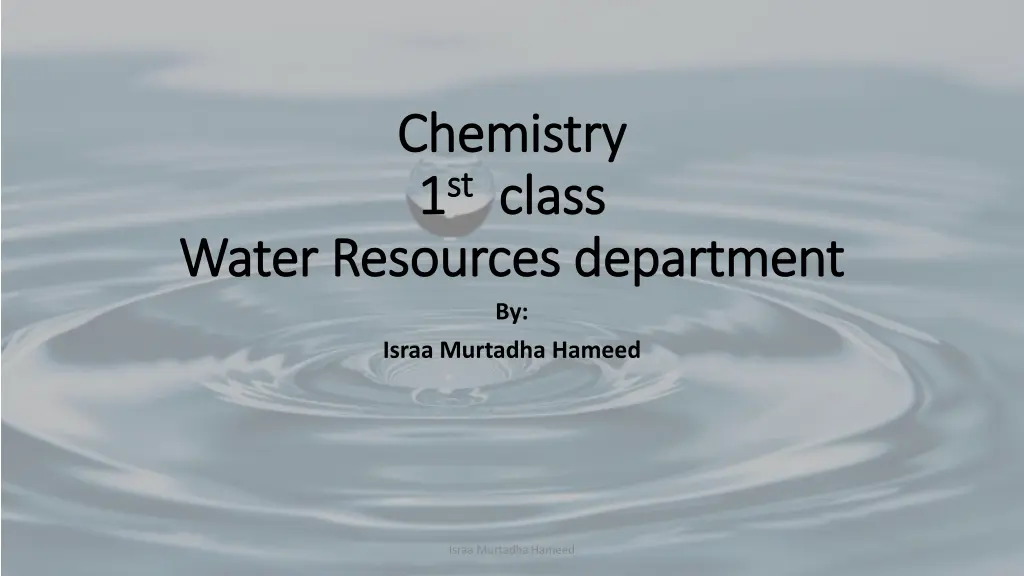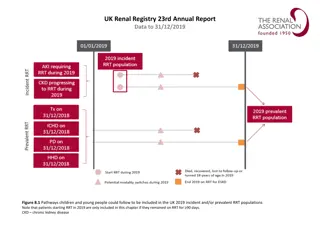
Chemical and Physical Properties of Water: Exploring its Unique Characteristics
Discover the fascinating world of water and its diverse properties, from being a tasteless, odorless liquid to a universal solvent. Learn about its molecular structure, surface tension, capillary action, and role as a key component in various natural phenomena. Dive into the intriguing realm of water's different forms and states, essential for life on Earth.
Uploaded on | 0 Views
Download Presentation

Please find below an Image/Link to download the presentation.
The content on the website is provided AS IS for your information and personal use only. It may not be sold, licensed, or shared on other websites without obtaining consent from the author. If you encounter any issues during the download, it is possible that the publisher has removed the file from their server.
You are allowed to download the files provided on this website for personal or commercial use, subject to the condition that they are used lawfully. All files are the property of their respective owners.
The content on the website is provided AS IS for your information and personal use only. It may not be sold, licensed, or shared on other websites without obtaining consent from the author.
E N D
Presentation Transcript
Chemistry Chemistry 1 1st stclass class Water Resources department Water Resources department By: Israa Murtadha Hameed Israa Murtadha Hameed
Chemical and Physical Chemical and Physical Properties of Water Properties of Water 2nd lecture By: Israa Murtadha Hameed Israa Murtadha Hameed
Introduction Introduction Water is the chemical substance with chemical formula H2O: one molecule of water has two hydrogen atoms covalently bonded to a single oxygen atom. Water appears in nature in all three common states of matter and may take many different forms on Earth: water vapour and clouds in the sky; seawater and icebergs in the polar oceans; glaciers and rivers in the mountains; and the liquid in aquifers in the ground. At high temperatures and pressures, such as in the interior of giant planets, it is argued that water exists as ionic water in which the molecules break down into a soup of hydrogen and oxygen ions, and at even higher pressures as superionic water in which the oxygen crystallises but the hydrogen ions float around freely within the oxygen lattice. Israa Murtadha Hameed
The major chemical and physical properties of The major chemical and physical properties of water water water is a tasteless, odourless liquid at standard temperature and pressure. The colour of water and ice is, intrinsically, a very slight blue hue, although water appears colourless in small quantities. Ice also appears colourless, and water vapour is essentially invisible as a gas. water is transparent, and thus aquatic plants can live within the water because sunlight can reach them. Only strong UV light is slightly absorbed. . Israa Murtadha Hameed
The major chemical and physical properties of The major chemical and physical properties of water water Since the water molecule is not linear and the oxygen atom has a higher electronegativity than hydrogen atoms, it carries a slight negative charge, whereas the hydrogen atoms are slightly positive. As a result, water is a polar molecule with an electrical dipole moment. Water also can form an unusually large number of intermolecular hydrogen bonds (four) for a molecule of its size. These factors lead to strong attractive forces between molecules of water, giving rise to water's high surface tension and capillary forces. The capillary action refers to the tendency of water to move up a narrow tube against the force of gravity. This property is relied upon by all vascular plants, such as trees. Israa Murtadha Hameed
The major chemical and physical properties of The major chemical and physical properties of water water Water is a good solvent and is often referred to as the universal solvent. Substances that dissolve in water, e.g., salts, sugars, acids, alkalis, and some gases especially oxygen, carbon dioxide (carbonation) are known as hydrophilic (water-loving) substances, while those that do not mix well with water (e.g., fats and oils), are known as hydrophobic (water-fearing) substances. All the major components in cells (proteins, DNA and polysaccharides) are also dissolved in water. Israa Murtadha Hameed
The major chemical and physical properties of The major chemical and physical properties of water water Pure water has a low electrical conductivity, but this increases significantly with the dissolution of a small amount of ionic material such as sodium chloride. The boiling point of water (and all other liquids) is dependent on the barometric pressure. For example, on the top of Mt. Everest water boils at 68 degrees Celsius, compared to 100 degrees Celsius at sea level. Conversely, water deep in the ocean near geothermal vents can reach temperatures of hundreds of degrees and remain liquid. water has the second highest molar specific heat capacity of any known substance, after ammonia, as well as a high heat of vaporisation (40.65 kJ mol-1), both of which are a result of the extensive hydrogen bonding between its molecules. These two unusual properties allow water to moderate Earth's climate by buffering large fluctuations in temperature. Israa Murtadha Hameed
The major chemical and physical properties of The major chemical and physical properties of water water The maximum density of water occurs at 3.98 degrees Celsius. It has the anomalous property of becoming less dense, not more, when it is cooled down to its solid form, ice. It expands to occupy 9 percent greater volume in this solid state, which accounts for the fact of ice floating on liquid water. Israa Murtadha Hameed
pH: Alkalinity/Acidity pH: Alkalinity/Acidity The measurement of the H+ ions found in that particular substance The scale goes from 0 to 14 7 is neutral Below 7 is acidic Above 7 is alkaline (or basic) Israa Murtadha Hameed






















